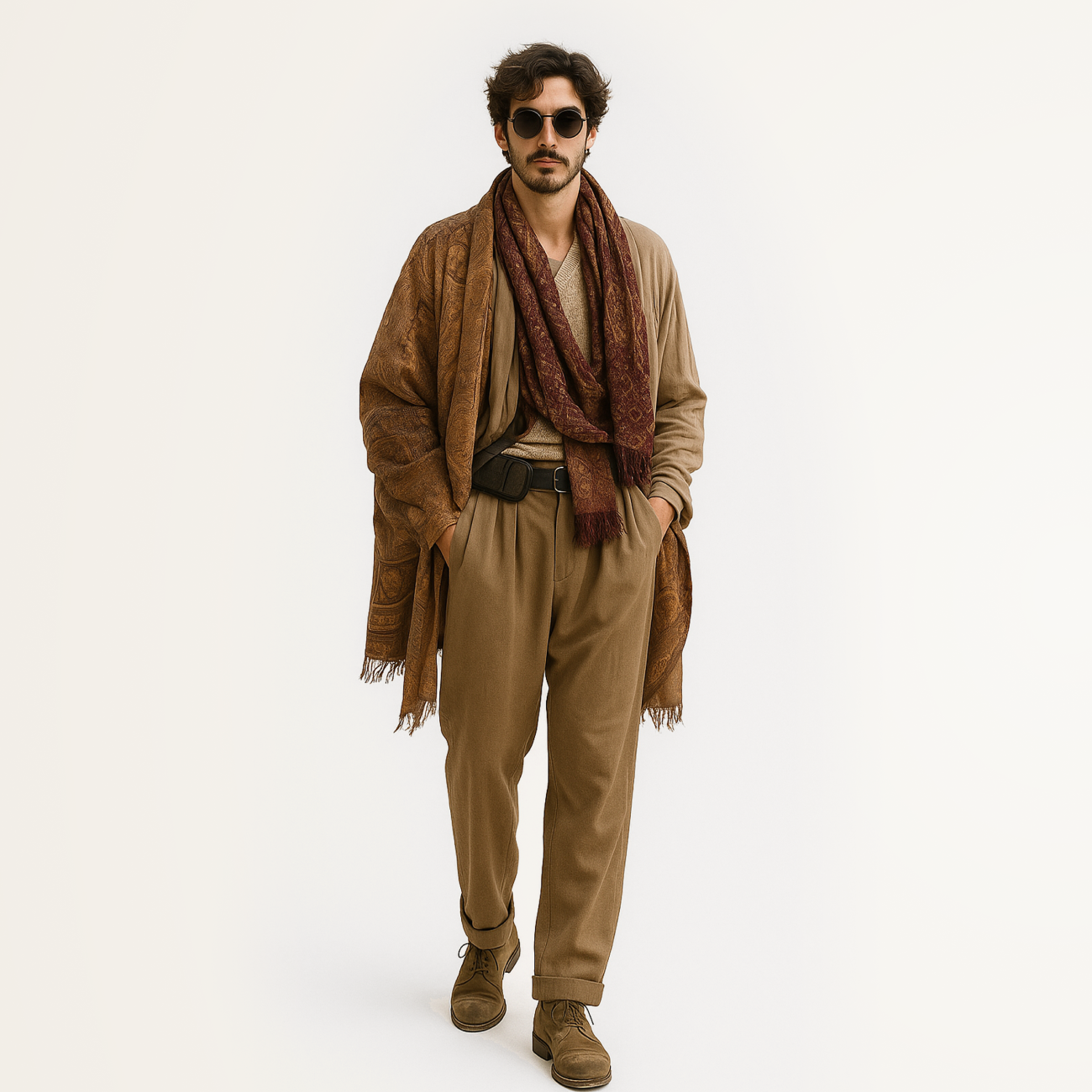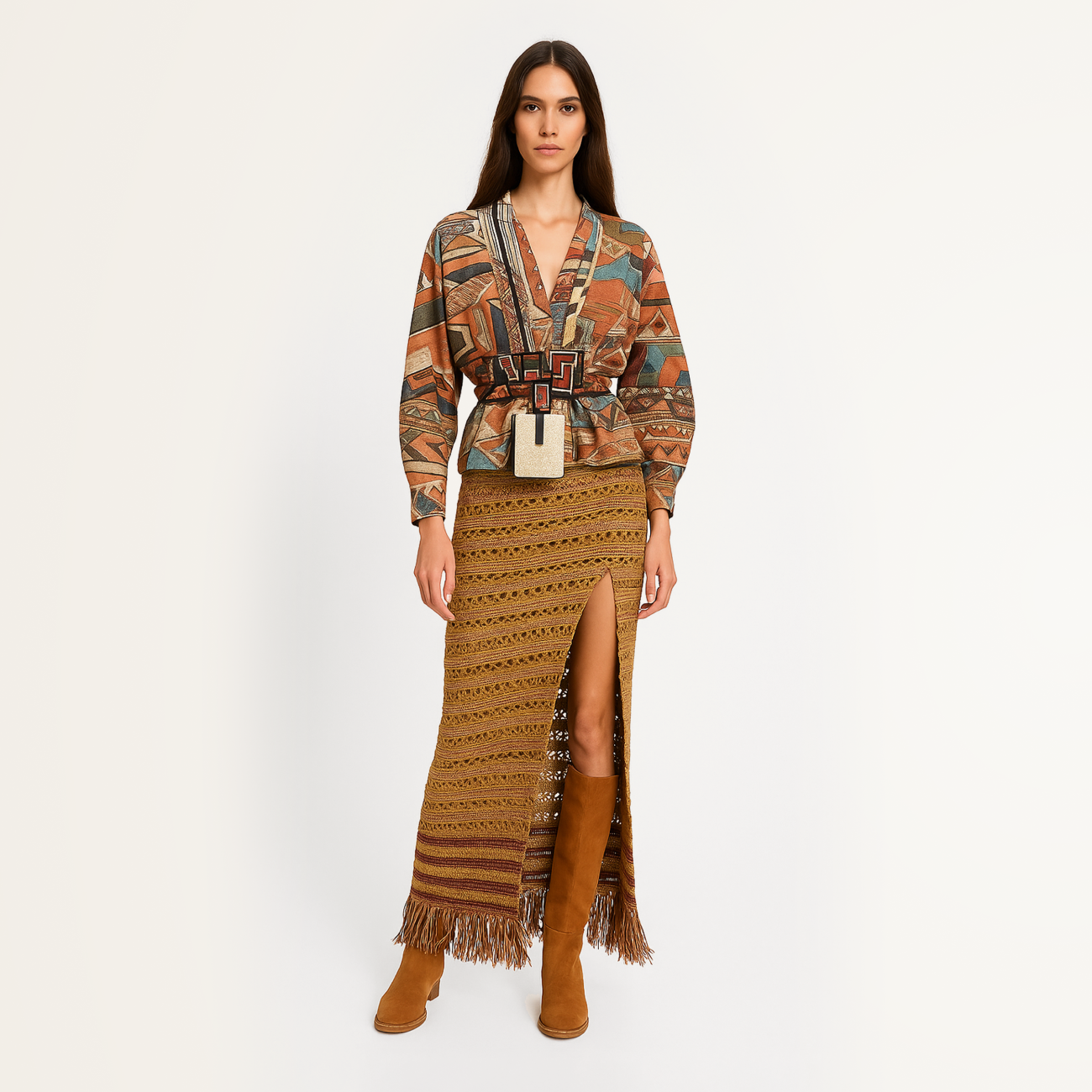Ethnic
Ethnic style is not just an ode to culture, but also a way to express respect for the world’s diversity. This style embodies a philosophy of connection with nature, history, and the symbolism of different peoples. Ethnic elements allow one to immerse in a look inspired by the cultures of various countries, evoking a sense of belonging to the collective human experience.
History
In the 20th century, ethnic style became a subject of mass interest. Initially, it gained popularity among artists and travelers who sought to go beyond Western culture and find inspiration in the exotic. During the 1960s–1970s, ethnic style experienced a true boom: youth subcultures such as the hippies, who stood against social conformity, began incorporating elements of other cultures as a protest against mass consumption and standardization. Young people were inspired by the rich traditions and patterns of India, Africa, Central and South America, emphasizing their commitment to the ideals of peace, love, and freedom.
It was during this time that ethnic style gained traction in high fashion. Designers began actively incorporating ethnic motifs into their collections — from African prints and Indian jewelry to Eastern fabrics. Ethnic style made its way onto the runways of Paris, New York, and London, becoming part of haute couture. At this stage, ethnic elements were adapted and mixed with European traditions, giving rise to a unique \
Signature elements of the style
Color palette
Colors vary depending on the region, but overall, ethnic style gravitates toward rich and natural tones. Bright reds, oranges, blues, and deep greens are commonly found. Some ethnic directions also incorporate pastel and earthy shades.
Prints
Ethnic style often features traditional patterns — from geometric ornaments to floral motifs. Asian cultures tend toward botanical designs, Arab cultures favor arabesques, while African traditions highlight animalistic and abstract patterns.
Textures
Natural fabrics are widely used in this style, such as cotton, linen, wool, suede, and leather. These materials offer a unique tactile experience that enhances the authenticity of the ethnic look.
Cuts & silhouette
Garments in ethnic style tend to have a loose, comfortable cut, often incorporating layered elements such as ponchos, tunics, capes, and kimonos. The style emphasizes ease and natural movement, with silhouettes that allow freedom and breathability.
Wardrobe essentials
- Tunic or kimono — loose, fluid garments that drape easily.
- Ponchos and capes — traditional items found in Latin American and other regional dress.
- Wide-leg pants or skirts — often adorned with rich ornamentation or decorative trim.
- Vest — frequently embellished with embroidery or appliqué, a signature of ethnic chic.
- Accessories — a key element of the ethnic style: bold jewelry, earrings, bracelets, and necklaces, often handmade and featuring traditional motifs.
Substyles
- African Style – bold colors, geometric and animal prints, natural fabrics. Accessories include wood, metal, and leather, featuring bright, oversized jewelry.
- Native American Style – inspired by the cultures of Indigenous North American peoples. Defined by the use of natural materials such as leather, suede, and fur, and a palette of earthy tones like brown, terracotta, sand, forest green, and deep blue. Characterized by intricate geometric patterns and motifs symbolizing nature, spirits, and animals.
- Latin American Style – vibrant color and texture combinations, layered skirts and ponchos, fringe, and woven elements.
- Scandinavian Style – leans toward a neutral palette, often incorporates wool fabrics, sweaters with traditional patterns, and coarse natural textiles.
- Oriental Style – includes kimonos, silk fabrics, floral motifs, and influences from Arab countries.
- Asian Style – marked by refinement and intricate patterns, especially in fabrics like silk and brocade. Inspired by traditional garments such as the Japanese kimono, Chinese hanfu, or Korean hanbok.
- Slavic Style – inspired by traditional Slavic dress, rich in embroidery and symbolic patterns representing fertility, the sun, and protection. Key elements include embroidered blouses, sarafans, long skirts, headscarves, and floral wreaths.
- Greek Style – inspired by ancient Greek silhouettes and aesthetics, featuring draped fabrics, tunics, peplos, and chitons.
- Indian Style – abundant in vivid colors and intricate embroidery. Signature garments include saris, churidars, salwars, and kameez, often adorned with gold and silver threadwork.
- Gypsy Style – vibrant, saturated colors, layered skirts, headscarves, bold prints, and an abundance of jewelry and accessories.
Email: support@belt-app.com


















